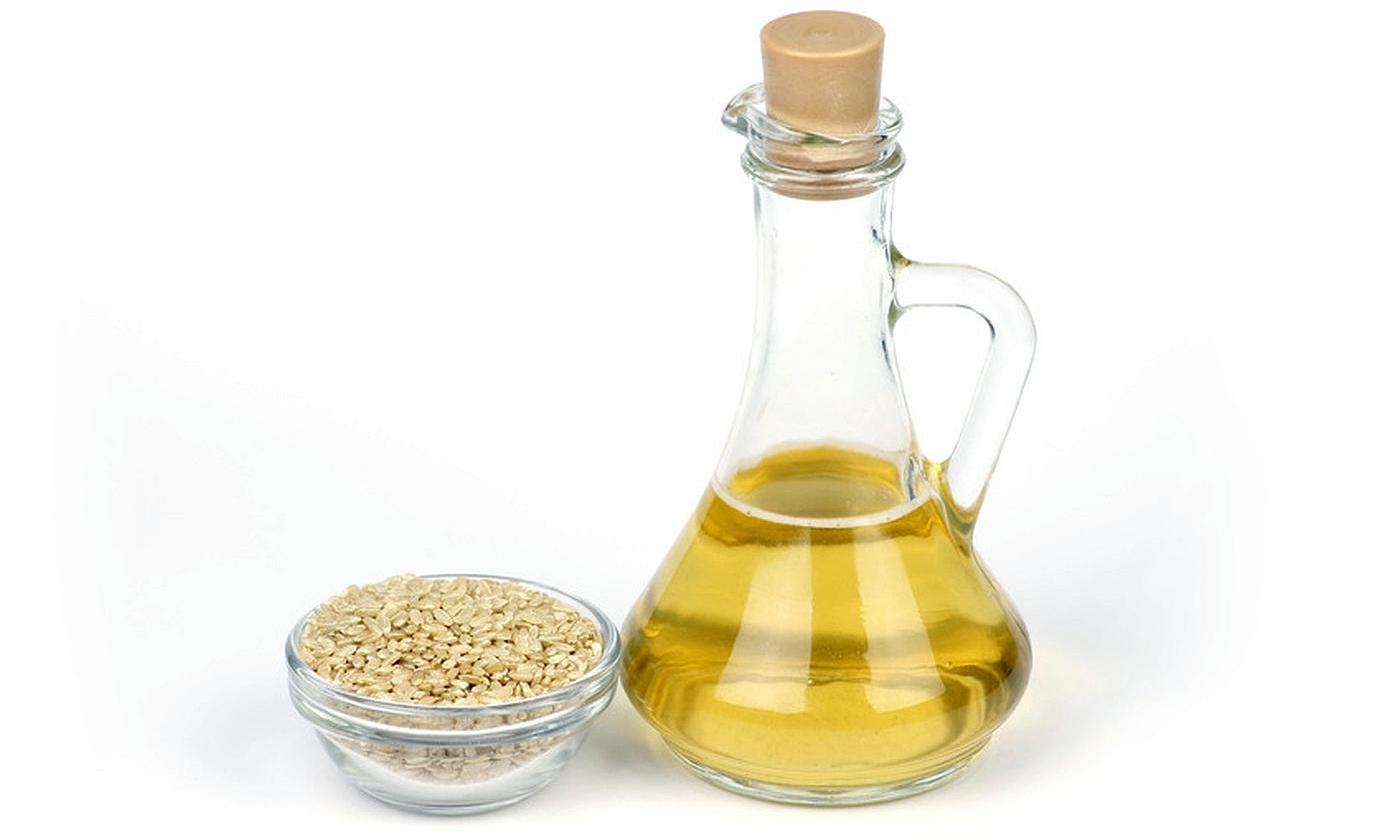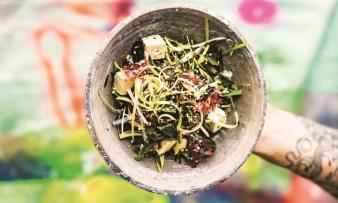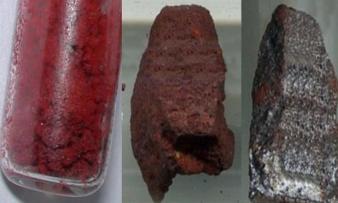Table of contents
Compared to European types of vinegar, rice vinegar or rice wine vinegar has a mild, reduced acidity. Rice vinegar, which originally comes from China, is traditionally used to prepare sweet and sour marinades for rice, vegetables and ginger . Rice vinegar is vegan and can occasionally be found in organic quality ( organic ).
Using rice vinegar in the kitchen:
How do you use rice vinegar? In Asian cuisine, rice vinegar is often used to season sushi rice or as a sushi rice marinade. There are two variants:
- Sushizu (or Sushi Su), a seasoning marinade made from salt and sugar dissolved in rice vinegar, can be mixed into hot, cooked sushi rice . This gives the rice its shine and authentic flavor.
- Or you can add Sushinoko , a ready-seasoned rice vinegar powder mixture, directly to the cooking water. For 300 g of rice you need a teaspoon of the chemically bound acetic acid, which is only released when the powder comes into contact with water.
Rice vinegar is also used to flavor soups, salads, sauces or seaweed, as well as for preserving or marinating. The sweet and sour Sushizu marinade made from rice vinegar, sugar and salt is also ideal for marinating a wide variety of vegetables, e.g. cucumbers , mixed pickles, carrots or garlic .
A typical Asian speciality is Gari. These are sweet and sour pickled, wafer-thin ginger slices that are often eaten as a side dish with sushi (sushi ginger) to neutralize the taste in the mouth between dishes. But other vegetables can also be pickled in rice vinegar.
There are three different types of rice vinegar:
- White rice vinegar : Clear rice vinegar has a mild, gentle taste and is colorless to pale yellow. The light rice vinegar can be used to season sushi rice and refine vegetable dishes.
- Black rice vinegar : The rice vinegar gets its dark color from the addition of sugar or caramel. The slightly malty taste is reminiscent of soy sauce. It is often used to refine wok dishes.
- Red rice vinegar : This rice vinegar gets its red color from the addition of the fungus Monascus purpureus during the manufacturing process. The vinegar is often used to season spicy dishes and for dips.
Ma-Kurozu vinegar is also a variation of rice vinegar, but it differs from other types of vinegar in that it contains both brown rice and wheat . The vinegar has a very dark color and a slightly chocolatey taste. Diluted, it can be drunk as an aperitif or used to refine, marinate and season vegetables and tofu. 1
How can you replace rice vinegar? If you don't have any rice vinegar at home, you can use light balsamic vinegar or a mixture of apple cider vinegar and white wine as an alternative (as a rice vinegar substitute). Brown balsamic vinegar is the best option for replacing black rice vinegar. Since rice vinegar is milder than the other types of vinegar, you should always reduce the amount of vinegar when using an alternative.
Vegan rice vinegar recipe for peanut sauce:
Ingredients (for 4 people): 65 g peanut butter , 2 tbsp soy sauce , 2 tbsp sesame oil , 1 tbsp rice vinegar (organic), 1 tsp maple syrup , 1 clove of garlic, 1 chili pepper , the juice of half a lime ( lime juice ), 2 tsp water (as needed).
Preparation: First, chop the garlic clove very finely and chop the fresh chili pepper. Next, put all the ingredients (except water) in a bowl and mix them well together. You should end up with a thick sauce. By adding a little water, you can change the consistency of the sauce until it reaches the desired consistency. You can garnish the peanut sauce with fresh herbs, spring onions or chopped peanuts. Vegan peanut sauce with rice vinegar is suitable as a delicious salad dressing, pasta sauce or as a dip for spring or summer rolls. When it comes to peanuts , it is advisable to consume them in moderation.
Vegan rice vinegar recipe for rice balls:
Ingredients (for 12 balls): 250 g sushi rice, 1 tbsp rice vinegar (organic), 2 tbsp soy sauce (tamari) , ½ tsp sugar , 2 tsp sesame oil , 3 tbsp sesame seeds .
Preparation: Boil the sushi rice briefly in hot water and then simmer on a low heat until it is cooked. Then pour the rice into a bowl and gently stir in the sesame oil, soy sauce, sugar, sesame seeds and rice vinegar. Prepare a small bowl of water and baking paper for forming the rice balls. A heaped tablespoon of rice per ball is ideal. Form the rice into a ball with moistened hands. Place the finished rice balls on the baking paper to cool. Do the same with the remaining rice until all of it is used up. Once the rice balls have cooled completely, you can serve them with a little soy sauce or the peanut sauce described above. The vegan rice balls will keep in the fridge for 2-3 days.
If you prefer something healthier, you should try the recipe with naturally sweet mochi rice (whole grain) and no added sugar.
Vegan recipes with rice vinegar can be found under the note: " Recipes that have the most of this ingredient ".
| Not only vegans or vegetarians should read this: Vegans often eat unhealthily. Avoidable nutritional mistakes . |
Shopping - where to buy rice vinegar?
Rice vinegar (always vegan) from China, Japan or Korea can be found not only in Asian shops and Asian markets, but also online and in the Asian department of supermarkets such as Coop , Migros , Rewe , Spar and Edeka . Rice vinegar powder mixes (sushinoko or sushinoko powder) and ready-made rice vinegar marinades (e.g. Sushizu) can be found almost exclusively in Asian shops and online. Occasionally (usually light) rice vinegar is available as part of special offers (e.g. "Asia weeks") at discounters such as Aldi , Lidl or Hofer . We could not find a comparable product at Denner or Volg . Organic rice vinegar (organic) is available from organic shops, organic supermarkets ( Denn's Biomarkt , Alnatura ) and health food stores, or you can search for it on the Internet.
Normally, the acidity of rice vinegar is 3-4% acetic acid, but you can also find strong rice wine vinegar with more than 4% acid. Chinese rice vinegar is generally said to be richer in acetic acid. Rice vinegar powder mixes contain not only powdered fermented rice vinegar but also an acidity regulator (e.g. E334 tartaric acid, E297 fumaric acid, E296 malic acid) as well as salt and sugar.
Clear or white rice vinegar is the most common in stores and is the cheapest of the three types of vinegar mentioned. The range of black and red rice vinegar is much smaller.
Storage of rice vinegar:
Shelf life: Can rice vinegar go bad? Due to the preservative properties of acetic acid, rice vinegar has an extremely long shelf life even when opened. How long does rice vinegar last? If you store it in a cool, dark place, you should be able to keep rice vinegar for two years. If rice wine vinegar becomes cloudy or changes its smell, you can at least still use the vinegar for cleaning purposes, e.g. for descaling.
Rice vinegar ingredients - nutritional values - calories:
What is special about rice vinegar? Classic rice vinegar contains only three to four percent acetic acid, which is less than the types of vinegar commonly used in Europe, such as brandy vinegar, apple cider vinegar or wine vinegar , which contain five to six percent. In Germany in particular, vinegar must contain at least five percent acid, but rice vinegar seems to be an exception. If it were produced under European conditions, rice vinegar would have a similar acid content to other types of vinegar. However, the mildness of rice vinegar meets the wishes of Asian consumers.
100 g of rice vinegar contains 16 kcal. Rice vinegar contains neither fat nor fiber nor carbohydrates. Proteins are only present in negligible amounts.
Manganese is also one of the ingredients in rice vinegar: 100 g of rice wine vinegar contains 0.2 mg of this trace element. This covers 10% of the daily requirement. Soy milk and fresh baking yeast contain a similar amount of manganese. Spices such as cardamom (28 mg/100g) and saffron (28.4 mg/100g) contain significantly more manganese. 2 The human body needs manganese for its carbohydrate metabolism, its urinary cycle and for the formation of cartilage tissue, among other things. 3
The magnesium content is 22 mg/100g, which covers 6% of the daily requirement. Maple syrup and soy yogurt contain comparable amounts. Sea salt (501 mg) and agar-agar (770 mg) contain a lot of the element. 2 Magnesium is considered an essential macronutrient and is involved in over 300 enzymatic metabolic reactions. 4
The complete ingredients of rice vinegar, the coverage of the daily requirement and comparison values with other ingredients can be found in our nutrient tables. In the article Nutrients explained you will get a detailed insight into the topic.
Health aspects:
Is rice vinegar healthy? Foods containing acetic acid in small concentrations stimulate the flow of saliva, stomach acid and the production of digestive juices in the intestines. The acidic environment in the small intestine, which the organic acids create, improves the absorption of minerals, especially iron . However, most of the acid is quickly neutralized, so that it is ineffective. In the metabolism, acetic acid is converted to carbon dioxide and water and the remaining minerals have an alkaline effect. In this way, vinegar can possibly prevent over-acidification. Acetic acid also works against bacteria. Gargling with vinegar water can help with inflammation, for example. 2
Rice vinegar is also said to help with weight loss. Studies show that oral intake of rice wine vinegar can reduce excess weight. It is assumed that the acid contained in the vinegar is responsible for the slight weight loss effect. 5
The antioxidants contained in the vinegar also prove that rice vinegar is healthy. These can intercept and neutralize harmful free radicals that the body forms during metabolic reactions. 6,7,17 Free radicals are highly reactive and very aggressive chemical oxygen molecules or inorganic compounds. Since free radicals have unpaired electrons, they try to rob the atoms and molecules in the human body of their electrons. This creates new free radicals and leads to a dangerous chain reaction, known as oxidative stress. 8
Dangers - side effects - intolerances:
Is too much vinegar unhealthy? You should avoid taking large amounts of rice vinegar, as the acid attacks your teeth and irritates your stomach.
Due to the use of fertilizers and pesticides in rice-growing countries, the groundwater in some regions is heavily contaminated with arsenic and cadmium. Foods made from rice therefore contain a certain amount of arsenic, including rice vinegar. Since small children absorb arsenic even more easily than adults, children under the age of 3 should not be given too many rice products. 9
Use as a remedy:
Vinegar, especially apple cider vinegar , is considered an ancient home remedy in naturopathy. The healers in ancient Babylon used the essence of vinegar andherbal vinegar to relieve swelling, inflammation, fever or to clean wounds. At the time they were called "vinegar and oil experts". The mother of vinegar, which consists of a collection of acetic acid bacteria and is recognizable by gelatinous streaks, is also said to have positive healing effects. For example, a spoonful of mother of vinegar is said to have a positive effect on arthritic joint pain, increased susceptibility to infectious diseases and many other complaints. 10
There are numerous publications and references in the literature to its effectiveness as an old remedy, but there is no scientific evidence for this. Therefore, vinegar should not be viewed as a medicine that you can prescribe yourself. In consultation with a therapist, (apple) vinegar can possibly have a positive effect on the healing process, for example in the case of heartburn or gastrointestinal complaints. 10
Occurrence - Origin:
Rice vinegar is used primarily in Asia, as this is where vinegar from fermented rice originated. Rice vinegar has been used for centuries in China, Japan and Korea to refine dishes. It is said that China brought rice vinegar to Japan in the 4th century. 15 Rice wine vinegar is now becoming increasingly popular in European kitchens as well, as it is a milder alternative to our domestic vinegars.
Fermenting food is a tradition that goes back thousands of years and has been known to people since the Neolithic period at the latest. Around 7,000 BC, people in China began to produce fermented drinks based on rice, honey and fruit. 16 Fermentation allows food to last longer and thus changes its taste. In history, fermentation was considered very mysterious. It was often associated with rituals because it was believed that the gods had a hand in it. How else could easily spoiled food suddenly last so long? Over the years, however, fermentation lost its religious significance.
What does fermentation do? During fermentation, microorganisms break down carbohydrates into gases, alcohol and acids. However, the process should not be confused with putrefaction, which produces toxic and bad-smelling substances. Instead, fermentation is a refinement process that is intended to optimize the shelf life of food. 11
Rice vinegar production:
With this technique you can make rice vinegar: There are two methods for making rice vinegar.
Japanese rice vinegar, for example, is traditionally made from the Japanese rice Urumai in a two-stage fermentation 17. The ingredients of rice vinegar include water and wholegrain rice. In acetic acid fermentation (2nd stage), ethyl alcohol is converted to acetic acid with the help of acetic acid bacteria ( Acetobacter ) and oxygen. In contrast to alcoholic fermentation, the supply of air is necessary for acetic fermentation to trigger an oxidation process. 12
To make it, you first have to steam the rice, then add yeast bacteria, koji spores and spring water to start the fermentation process. What are koji spores? Koji spores can be used to make sauces, alcohol and vinegar. To make rice vinegar, you use the spores of the mold genus Aspergillus oryzae, which thrive on rice or other grains.
Once the first fermentation process is complete, the alcoholic base for the rice vinegar, known as "sumoto moromi", is obtained. The next rice vinegar ingredient is acetic acid bacteria, which use oxygen to convert the alcohol into water and acetic acid (second stage). The traditional method involves storing the vinegar for 2-3 years (or longer) to achieve a milder, smoother taste.
In addition to the traditional and much more time-consuming production technique, the industry can now benefit from a rapid production method . This involves skipping the fermentation process of rice (first stage) by using rice wine instead and mixing it with sugar and yeast. Sometimes chemicals are added to the mixture to speed up the fermentation. This type of production is much more suitable for mass production than the traditional production method, as it can save a lot of time. 13
General information about rice vinegar:
Rice vinegar (rice wine vinegar) made from fermented rice or rice wine mostly comes from Japan, China or Korea (Japanese: Komesu or Komezu 米酢, Chinese: Mi Cu 米醋, Korean: Ssal sikcho or sigcho 쌀식초) and is a particularly mild vinegar that usually only contains three to four percent acetic acid. There is also Vietnamese and Thai rice vinegar.
Alternative names:
In addition to rice wine vinegar, rice vinegar is also known as sushi vinegar (sushi vinegar) or rice vinegar seasoning (rice vinegar seasoning). You can also find the spelling rice vinegar or sushi rice vinegar (rice vinegar sushi).
In English, the name for rice vinegar is rice vinegar and for rice wine vinegar, rice wine vinegar. White rice vinegar is called white rice vinegar, black rice vinegar and red rice vinegar.
Keywords for use:
Rice vinegar can be used like normal vinegar to clean work surfaces and tiles in the home or to descale. The acetic acid contained in the vinegar dissolves dirt and grease, so that the kitchen and bathroom quickly shine like new.
Rice vinegar can be used for cosmetic purposes as a toner. Toners are care products that you apply after cleansing your facial skin. Together with distilled water and tea tree oil, the toner with rice vinegar is a natural alternative to the products available in drugstores. Rice vinegar is said to tighten the skin, prevent infections, reduce inflammation and make the skin glow. 14
Literature - Sources:









Comments